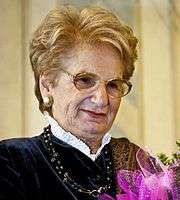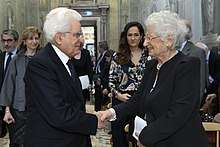Liliana Segre
Liliana Segre OMRI (Italian pronunciation: [liˈljaːna ˈsɛːɡre, - ˈseːɡre]; born 10 September 1930) is an Italian Holocaust survivor, named Senator for life by President Sergio Mattarella in 2018 for outstanding patriotic merits in the social field.[1]
Liliana Segre | |
|---|---|
.jpg) Liliana Segre in 2018 | |
| Senator for Life | |
| Assumed office 19 January 2018 | |
| Appointed by | Sergio Mattarella |
| Personal details | |
| Born | 10 September 1930 Milan, Kingdom of Italy |
| Political party | Independent |
| Spouse(s) | Alfredo Belli Paci
( m. 1951; d. 2007) |
| Children | 3 |
| Alma mater | Sapienza University of Rome University of Bergamo University of Trieste University of Verona |
| Known for | Holocaust survivor |
Born in 1930 into a Milanese family of Jewish origins, in 1938 Segre was expelled from her primary school after the promulgation of the Italian Racial Laws. In 1943 she was arrested with her family and deported to the Auschwitz concentration camp. The only survivor among her relatives, with the end of the war in 1945 she returned to Milan. After decades of silence, in the 1990s she started to speak to the public, especially young people, about her experience.
Biography

Born in Milan into a family of Jewish origins, Segre lived with her father Alberto and her paternal grandparents, Giuseppe Segre and Olga Loevvy. Her mother, Lucia Foligno, died when Liliana was not yet one year old. Her family was secular, and the awareness of being Jewish came to Liliana only after the drama of the Italian Racial Laws of 1938, after which she was expelled from school.[2]
After the intensification of the persecution of the Italian Jews, her father hid her at a friend's home, using false documents. On 10 December 1943, at the age of thirteen, together with her father, Segre tried to flee to Switzerland, but both were rejected by the Swiss authorities.[3] The next day, she was arrested by fascists in Selvetta di Viggiù, Varese. After six days in prison in Varese, she was transferred to Como and finally to Milan, where she was detained for 40 days.
On 30 January 1944, Segre was deported from platform 21 of the Milan Central railway station to the Auschwitz concentration camp, where she arrived seven days later. She was immediately separated from her father Alberto, whom she never saw again and who would be killed on 27 April 1944 (see the memorial plaque below). On 18 May 1944 her paternal grandparents were arrested in Inverigo, in the Province of Como, and deported after a few weeks to Auschwitz, where they were also killed on their arrival on the 30 June.[2]
At the selection, Segre was tattooed with the serial number 75190. She was employed in forced labour in the Union ammunition factory, which belonged to Siemens, for about one year. During her imprisonment, she underwent three other selections. In January 1945, after the evacuation of the camp, she faced the death march towards Ravensbrück concentration camp in Germany. After some weeks spent there in terrible conditions, she was marched on to its satellite Malchow concentration camp where she was liberated by the Red Army on 1 May 1945.[4] Out of the 776 Italian children aged 14 or younger who were deported to the Auschwitz concentration camp, only 35 survived.[5]
After the Nazi Holocaust, Segre moved to the Marche region where she lived with her maternal grandparents, the only surviving members of her family. In 1948 Liliana met Alfredo Belli Paci, a Catholic who had also survived the Nazi concentration camps, where he was sent for refusing to join the Italian Social Republic. The two married in 1951 and had three children.[6][7]
Testimony
.jpg)
For a long time, Segre never wanted to speak publicly about her experience in concentration camps. Like many Holocaust children, returning home and to a "normal" life was far from easy. Liliana Segre also remembers that she did not find in those years any ear willing to listen to her:
"Era molto difficile per i miei parenti convivere con un animale ferito come ero io: una ragazzina reduce dall’inferno, dalla quale si pretendeva docilità e rassegnazione. Imparai ben presto a tenere per me i miei ricordi tragici e la mia profonda tristezza. Nessuno mi capiva, ero io che dovevo adeguarmi ad un mondo che voleva dimenticare gli eventi dolorosi appena passati, che voleva ricominciare, avido di divertimenti e spensieratezza."[8] |
It was very difficult for my relatives to live with a wounded animal like I was: A little girl who came back from hell, from whom obedience and resignation was demanded. Soon I learned to keep my tragic memories and deep sadness to myself. Nobody understood me, I was the one who had to adapt myself to a world that wanted to forget the painful events that had just past, that wanted to start again, eager for fun and carefree. |
It was only in the early 1990s that she decided to interrupt her silence: since then she went to school assemblies and conferences to tell young people her story, also on behalf of the millions of others who shared it with her and who have never been able to communicate it. In 1997, she was among the witnesses of the documentary film Memoria, presented at the Berlin International Film Festival.[9]

In 2004 Segre was interviewed, together with Goti Herskovits Bauer and Giuliana Fiorentino Tedeschi, by Daniela Padoan in Come una rana d'inverno. Conversazioni con tre donne sopravvissute ad Auschwitz (Like a frog in winter. Conversations with three women who survived from Auschwitz). In 2005 her story was retraced with more details in a book-interview by Emanuela Zuccalà, Sopravvissuta ad Auschwitz. Liliana Segre fra le ultime testimoni della Shoah (Survived in Auschwitz. Liliana Segre among the last witnesses of the Shoah.[10] Also in 2005, she gave a video interview lasting more than five hours to Doris Felsen which is available in the Online Archive ''Forced Labor 1939-1945'' (de)[11].
In 2009, Segre lent her voice to the project Racconti di chi è sopravvissuto (tales of those who have survived), a research conducted between 1995 and 2008 by Marcello Pezzetti on behalf of the Center of Contemporary Jewish Documentation of Milan, which led to the collection of testimonies of almost all Italian survivors from Nazi concentration camps still alive. In the same year, she participated in Moni Ovadia's film-documentary Binario 21 (Platform 21) directed by Felice Cappa, which was inspired by the poem Dos lid funem oysgehargetn yidishn folk ("The Song of the Murdered Jewish People") written by Russian poet Itzhak Katzenelson.[12]
On 27 November 2008, the University of Trieste awarded Segre with an honorary degree in Law.[13] On 15 December 2010, the University of Verona awarded her with an honorary degree in Pedagogy.[14]
Senator for life

On 19 January 2018, the 80th anniversary of the Italian Racial Laws, the President of the Italian Republic Sergio Mattarella, on the basis of article 59 subsection 2 of the Italian Constitution, appointed Segre as senator for life for outstanding patriotic merits in the social field.[15]
Segre is the fourth woman to hold such position, after Camilla Ravera, Rita Levi-Montalcini and Elena Cattaneo.
As the first legislative act, she proposed the establishment of a Parliamentary Control Commission on racism, anti-Semitism and incitement to hatred and violence, supported by Senator for life colleagues Renzo Piano and Elena Cattaneo. On 30 October 2019, the Senate of the Republic, with 151 votes in favor, approved the motion, which established the commission.[16]
On 7 November 2019, due to numerous threats received on the social medias, she was assigned a bodyguard by the Prefect of Milan, Renato Saccone.[17]
On 29 January 2020, invited by President David Sassoli for the International Holocaust Remembrance Day and the 75th anniversary of the liberation of Auschwitz, she spoke before the European Parliament, where she received an ovation by the full assembly.[18]
On 18 February 2020, during the Sapienza University of Rome academic year inauguration, also attended by President Sergio Mattarella, she was awarded a PhD honoris causa in European History, which she dedicated to her father Alberto, "killed for the guilt of being born (Jewish)".[19]
Bibliography
- Stefania Consenti (2011). Il futuro della memoria. Conversazioni con Nedo Fiano, Liliana Segre e Piero Terracina, testimoni della Shoah (in Italian). Edizioni Paoline.
- Sara Fantini (2005). Notizie dalla Shoah. La stampa italiana nel 1945 (in Italian). prefazione di Liliana Segre. Bologna: Edizioni Pendragon. ISBN 88-8342-403-4.
- Silvana Greco (2017). G. Busi; E. Finzi (eds.). La spirale del misconoscimento e la lotta per il riconoscimento di Liliana Segre, testimone della Shoah. Lombardia judaica. I secoli aurei di Mantova e un caso emblematico della Shoah milanese (in Italian). Milano: Giuntina. pp. 107–136.
- Bruno Maida (2013). La Shoah dei bambini (in Italian). Torino: Einaudi.
- Daniela Padoan (2004). Come una rana d'inverno (in Italian). Milano: Bompiani. ISBN 88-452-0117-1.
- Marcello Pezzetti (2009). Il libro della Shoah italiana (in Italian). Torino: Einaudi.
- Liliana Picciotto (2001). Il libro della memoria (in Italian). Milano: Mursia.
- Emanuela Zuccalà (2005). Sopravvissuta ad Auschwitz. Liliana Segre fra le ultime testimoni della Shoah (in Italian). Milan: Paoline Editoriale Libri. ISBN 978-88-315-2769-9.
References
- Profile, corriere.it; accessed 24 March 2018.(in Italian)
- Liliana Picciotto 2001
- "Liliana S., Italian Jew, deported to Auschwitz at age 13, Selected Short Biographies from the Interview archive Forced Labor 1939-1945. Memory and History". Retrieved 2019-09-21.
- "Segre, Liliana, Interview za124, 08.06.2005, Interview archive Forced Labor 1939-1945. Memory and History". Retrieved 2019-09-21.
- Bruno Maida 2013, pp. 254 and 267
- Alessia Rastelli (13 August 2012). "Mi capì vedendo il tatuaggio". Corriere della Sera. Archived from the original on 5 February 2016. Retrieved 19 January 2018.
- "Liliana Segre senatrice a vita, grande emozione a Pesaro/FOTO". il Resto del Carlino. 19 January 2018. Archived from the original on 19 January 2018. Retrieved 19 January 2018.
Cittadia onoraria, trascorre in città molta parte delle sue vacanze e qui ha incontrato il marito
- Liliana Segre (1996). Un’infanzia perduta. Voci dalla Shoah testimonianze per non dimenticare. Firenze: La Nuova Italia Editrice. p. 63.
- "Memoria - Italy 1997 - Dir: Ruggero Gabbai". Retrieved 2018-03-27.
- Liliana Segre; Emanuela Zuccalà (2005). Sopravvissuta ad Auschwitz: Liliana Segre fra le ultime testimoni della Shoah (in Italian). Milan: Paoline.
- "Segre, Liliana, Interview za124, 08.06.2005, Interview archive Forced Labor 1939-1945. Memory and History". Retrieved 2019-09-21.
- "Binario 21 (2009)".
- "Trieste: laurea "honoris causa" in Giurisprudenza a Liliana Segre". ANED. Archived from the original on 25 December 2008.
- "Laurea honoris causa a Liliana Segre". UniVRmagazine (in Italian). 2010-12-06.
- "Il Presidente Mattarella ha nominato Senatrice a vita la dottoressa Liliana Segre". Presidenza della Repubblica. 19 January 2018. Archived from the original on 19 January 2018. Retrieved 19 January 2018.
- "She survived Auschwitz. Now Liliana Segre gets attacked 200 times online each day". The Sydney Morning Herald. 2019-11-07. Retrieved 2019-11-07.
- Santucci, Andrea Galli and Gianni (2019-07-11). "Escort for Liliana Segre following insults and threats". Corriere della Sera (in Italian). Retrieved 2019-11-07.
- International Holocaust Remembrance Day - 75th anniversary of the liberation of Auschwitz: speech by Liliana SEGRE, senator for life, Senato della Repubblica, survivor of Auschwitz, retrieved 2020-03-19
- "Segre cites Levi as gets honorary degree - English". ANSA.it. 2020-02-18. Retrieved 2020-03-19.
External links

